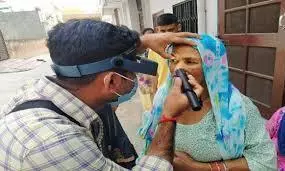India Has Met the Elimination Targets in the Battle Against Trachoma: WHO

Hyderabad: India has achieved a significant milestone in eliminating trachoma as a public health problem, a development that was validated by the World Health Organisation (WHO) on Wednesday. The global body confirmed that the country has met the elimination targets and dia joins Nepal, Myanmar, and 19 other countries that have previously eliminated trachoma.
The prevalence of trachoma, a leading cause of blindness worldwide, was first established in India between 1959 and 1963 as part of the Trachoma Control Pilot Project (TCPP).
The undivided Andhra Pradesh had low endemicity during this period with a prevalence rate of only 5.3 per cent as compared to 79.1 per cent in Punjab.
Trachoma still remains a public health issue in 39 countries, affecting about 1.9 million people.
TCPP, which is supported by both WHO and UNICEF, deployed some community-based interventions, including surgical treatments, antibiotics, water, sanitation, hygiene (WASH) initiatives, and health education, to curb the spread of the disease.
In 1976, these efforts were integrated into the National Programme for Control of Blindness and Visual Impairment (NPCBVI), extending the outreach to rural areas. By 2005, trachoma accounted for four per cent of all blindness cases in India and by 2018, its prevalence dropped to 0.008 per cent.
"India’s elimination of trachoma as a public health problem is a significant achievement. Trachoma, a bacterial infection that affects the eyelids and cornea, can lead to chronic complications, potentially causing vision loss. The disease thrives in warm, dry conditions and is particularly prevalent in north India, especially in Rajasthan and Punjab. Though various treatments exist, trachoma can still become a chronic issue if left untreated. Poor sanitation has been a major contributing factor, with about one in three patients affected by the disease 25 years ago," pointed out Dr. V. Rajalingam, former superintendent, of Sarojini Devi Eye Hospital.
"The incidence has decreased significantly in the last 10 years, with some cases seen very rarely, like patients from remote areas like Adilabad. Of late, we are seeing patients with sequelae (long-term effects of the infection) but there have been no fresh cases. After improving the health status in the state, this disease has been eradicated completely," Dr. Rajalingam said.
India is now focusing on sustaining its elimination efforts through post-validation surveillance. "Another similar bacterial infection, onchocerciasis, can also arise because of poor hygiene, and conditions like sarcoma. The country plans to eradicate the disease by 2030," Dr. Rajalingam said. This is one among the 21 diseases and disease groups that the country wants to eliminate by 2030. "Progress against these diseases is alleviating the burden on the most disadvantaged communities," the WHO noted.

